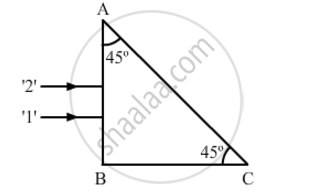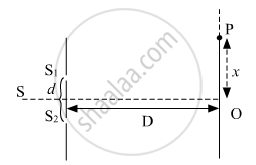Advertisements
Advertisements
प्रश्न
State with reason, how the linear width of the central maximum will be affected if
(i) monochromatic yellow light is replaced with red light, and
(ii) distance between the slit and the screen is increased.
उत्तर १
sin θ =`lambda/a`
where θ is a very small
sin θ = θ
aθ = λ
θ `= lambda/a`
θ `= x/D`
`lambda /a = x/D`
`x = (lambdaD)/a`
width in of central maxima
ω = 2x
`omega = 2x = (2 lambdaD )/a`
(i) `omega = (2 lambda D)/a`
if yellow light replaced by red light its wavelength increases so width will also increase.
(ii) If distance between slit & screen increased width will increase
उत्तर २
For a single slit experiment, the size(angular width) of the central maximum is given by `(2lambda)/"a"`, where a is the slit width.
So the width of the central maximum is directly proportional to the wavelength of light and inversely proportional to slit width.
(i) When monochromatic yellow light is replaced with monochromatic red light, the Width of the central maximum will increase, because the wavelength of red light is more than the wavelength of yellow light.
(ii) When the distance between the slit and the screen is increased, there is no effect on the width of the central maximum, as the width of the central maximum clearly depends only on wavelength and slit width, not on the distance of the screen from the slit.
संबंधित प्रश्न
Two monochromatic rays of light are incident normally on the face AB of an isosceles right-angled prism ABC. The refractive indices of the glass prism for the two rays '1' and '2' are respectively 1.3 and 1.5. Trace the path of these rays after entering the prism.

When monochromatic light is incident on a surface separating two media, why does the refracted light have the same frequency as that of the incident light?
State Huygen’s principle. Using this principle explain how a diffraction pattern is obtained on a screen due to a narrow slit on which a narrow beam coming from a `=> n = (vlamda)/(vlamda_omega)`monochromatic source of light is incident normally.
If a monochromatic source of light is replaced by white light, what change would you observe in the diffraction pattern?
Can the interference pattern be produced by two independent monochromatic sources of light? Explain.
Find the angle of incidence at which a ray of monochromatic light should be incident on the first surface AB of a regular glass prism ABC so that the emergent ray grazes the adjacent surface AC. (Refractive Index of glass = 1 .56)
Monochromatic fight of wavelength 198 nm is incident on the surface of a metallic cathode whose work function is 2.5 eV How much potential difference must be applied between the cathode and the anode of a photocell to just stop the photocurrent from flowing?
Answer the following question.
In the diffraction due to a single slit experiment, the aperture of the slit is 3 mm. If monochromatic light of wavelength 620 nm is incident normally on the slit, calculate the separation between the first order minima and the 3rd order maxima on one side of the screen. The distance between the slit and the screen is 1.5 m.
(a) Can the interference pattern be produced by two independent monochromatic sources of light? Explain.
(b) The intensity at the central maximum (O) in Young's double-slit experimental set-up shown in the figure is IO. If the distance OP equals one-third of the fringe width of the pattern, show that the intensity at point P, would `"I"_°/4`

(c) In Young's double-slit experiment, the slits are separated by 0⋅5 mm and the screen is placed 1⋅0 m away from the slit. It is found that the 5th bright fringe is at a distance of 4⋅13 mm from the 2nd dark fringe. Find the wavelength of light used.
A narrow slit is illuminated by a parallel beam of monochromatic light of wavelength λ equal to 6000 Å and the angular width of the central maximum in the resulting diffraction pattern is measured. When the slit is next illuminated by light of wavelength λ’, the angular width decreases by 30%. Calculate the value of the wavelength λ’.
